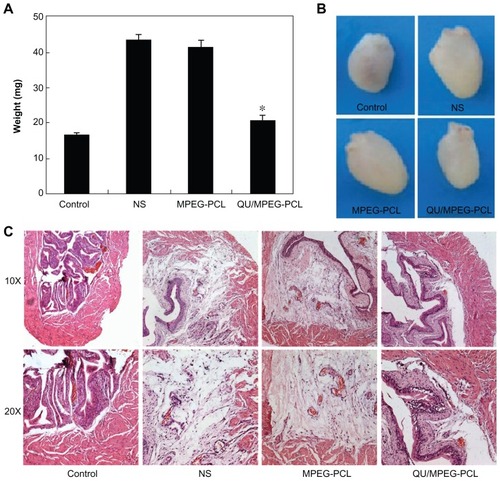Figures & data
Figure 1 Molecular structure of (A) quercetin and (B) monomethoxy poly(ethylene glycol)-poly(ɛ-caprolactone) copolymer.

Figure 2 Preparation of QU-loaded MPEG-PCL nanoparticles. MPEG-PCL and QU were co-dissolved in organic solvent, followed by evaporation to dryness under reduced pressure in a rotary evaporator, creating QU and MPEG-PCL mixture (QU + MPEG-PCL).
Notes: The QU and MPEG-PCL mixture was then hydrated in 0.9% normal saline, allowing QU and MPEG-PCL to self-assemble into QU/MPEG-PCL micelles. This micelle has a core-shell structure (hydrophilic PEG shell and hydrophobic PCL core) with core-encapsulated QU.
Abbreviations: MPEG, monomethoxy poly(ethylene glycol); PCL, poly(ɛ-caprolactone); QU, quercetin.
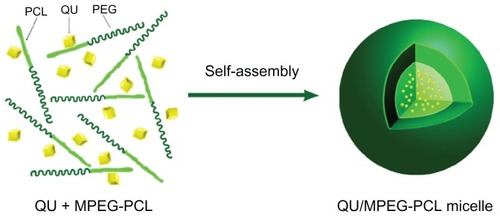
Figure 3 Characterization of QU/MPEG-PCL micelles: (A) size distribution spectrum of QU/MPEG-PCL micelles; (B) zeta potential spectrum of MPEG-PCL micelles; (C) transmission electron microscopy image of QU/MPEG-PCL micelles; (D) the encapsulation of QU in MPEG-PCL/QU nanoparticles renders QU completely dispersible in aqueous media (a, water (pH = 7.0); b, QU in water (pH = 7.0, 2 mg/mL); c, QU/MPEG-PCL micelles in water (pH = 7.0, 2 mg/mL).
Abbreviations: MPEG, monomethoxy poly(ethylene glycol); PCL, poly(ɛ-caprolactone); QU, quercetin.
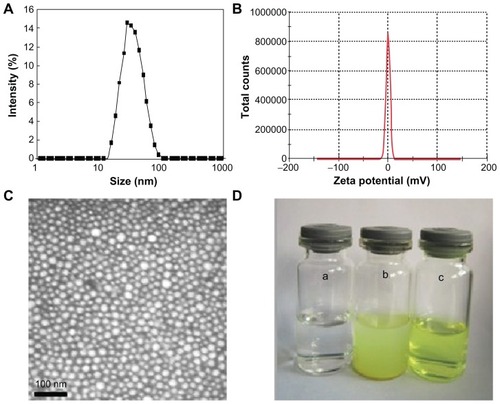
Figure 4 In vitro release study.
Note: The in vitro release profile of QU/MPEG-PCL micelles was examined using a dialysis method.
Abbreviations: MPEG, monomethoxy poly(ethylene glycol); PCL, poly (ɛ-caprolactone); QU, quercetin.
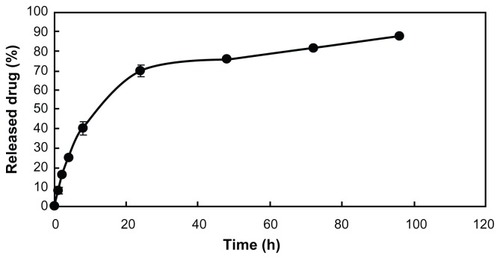
Figure 5 Acute toxicity of intravenously administered MPEG-PCL micelles (50 mg/mL × 0.1 mL) to bladder. (A) The weight of bladders in different treatment groups (P > 0.05); (B) hematoxylin and eosin assay of bladders in different treatment groups.
Note: Little difference was observed among these groups, which indicated that intravesical application of MPEG-PCL had little toxicity to bladder.
Abbreviations: MPEG, monomethoxy poly(ethylene glycol); NS, normal saline; PCL, poly(ɛ-caprolactone).

Figure 6 Tissue distribution of MPEG-PCL micelle-delivered cargo after intravenous (I.v.) or intravesical (I.ves.) application. The drug-associated green fluorescence indicated the deposition of drugs. (A) The fluorescence image of organs from mice 2 hours after intravenous or intravesical application of courmarin-6/MPEG-PCL micelles. (B) Fluorescence images of bladders from mice with intravenous or intravesical application of courmarin-6/MPEG-PCL micelles at different time points.
Abbreviations: MPEG, monomethoxy poly(ethylene glycol); PCL, poly(ɛ-caprolactone).
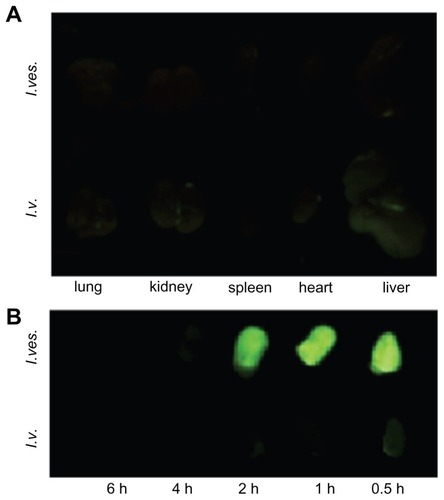
Figure 7 Therapeutic effects of intravesical application of QU/MPEG-PCL micelles on acute cystitis. (A) The weight of bladders in each treatment group. The weight of the bladder in the QU/MPEG-PCL group was less than that in the MPEG-PCL or NS group (P < 0.05). (B) Representative images of the bladders in each treatment group. The bladder in the QU/MPEG-PCL group was smaller than that in the NS group, while the bladder in the MPEG-PCL group was as large as that in the NS group. (C) Hematoxylin and eosin assay of the bladders from mice with Control, NS, MPEG-PCL, or Qu/MPEG-PCL treatment.
Notes: Severe edema and lots of inflammatory cell infiltration were observed in the bladders from both the empty MPEG-PCL micelle group and the NS group, indicating that MPEG-PCL had no effect on the treatment of cystitis. However, in the QU/MPEG-PCL treatment group, no obvious edema and inflammatory cell infiltration of the bladder was detected, suggesting that QU/MPEG-PCL micelles have promising application in acute cystitis therapy.
Abbreviations: MPEG, monomethoxy poly(ethylene glycol); NS, normal saline; PCL, poly(ɛ-caprolactone); QU, quercetin.
